Grown for its attractive foliage, the Calathea ornata produces large green leaves that are adorned with pink stripes.
It is these stripes that have earned the plant the nickname Calathea Pinstripe. The underside of its foliage has a deep pinkish purple hue and is just as attractive as the topsides of the leaves.
Like other Calathea varieties, the Calathea ornata has a reputation for being a picky plant that is hard to care for.
Let’s take a look at what is needed to care for this tropical plant so you can determine for yourself if this plant is too difficult to grow.
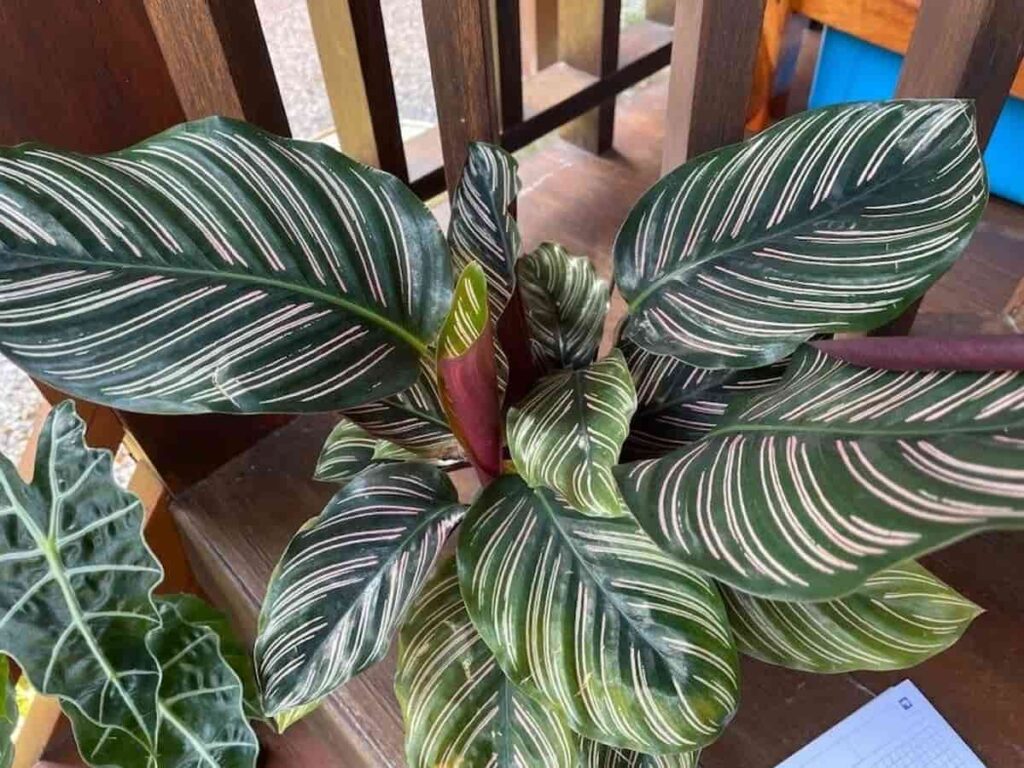
Table of Contents
Is calathea ornata easy to care for?
The Calathea ornata is one of the easier Calathea varieties to care for. While it does share many of the same growing requirements as other Calathea plants, it can also be planted in a wide array of planters and can thrive in various locations.
With that said, however, it can also be a bit fussy, which is something you should consider before deciding to grow this plant.
Just because it is fussy, however, doesn’t mean it isn’t easy to care for. If you have experience with any other Calathea varieties, or tropical houseplants in general, then you shouldn’t have any problems growing this plant. The most important thing is to ensure you provide the plant with its basic needs.
This means warm temperatures throughout the entire year, humidity levels of at least 50 percent, watering when the soil feels dry, bright light that is indirect, and soil that drains well while still retaining moisture.
What’s the best calathea ornata soil?
Calathea ornata thrives in moist soil that retains just enough water to keep it hydrated, while still providing good drainage. Traditional potting soil can be used for this plant as long as you amend it with some small sized gravel or orchid bark.
These can help improve drainage, while allowing the roots to grow and spread quicker.
There are commercially available soils designed for use with Calathea plants, but these are typically much more expensive and often times not worth the extra cost. You can achieve the same results by mixing your own Calathea ornata soil.
Related: Best Calathea Soil: Tips to Pick the Right Potting Mix
How often should I fertilize calathea ornata?
During the spring and summer months, when the Calathea ornata is actively growing, fertilize the plant once every 14 to 30 days. Use a balanced, liquid fertilizer designed for houseplants and apply it at half its strength.
Any feeding you are doing should be stopped in the fall and winter, which is considered the plant’s dormant period. If you continue to feed the Calathea ornata during this time, you could disrupt its natural growth cycle.
To help prevent damage to the Calathea ornata caused by improper fertilization, read and follow the instructions printed on the label. Additionally, you shouldn’t use fertilizer that is old or low in quality.
What’s the best calathea ornata fertilizer?
The best fertilizer for this plant is one designed for tropical houseplants that has a balanced NPK ratio, such as 10-10-10. Select a fertilizer that is in liquid form, and not granular or pellets, and apply the Calathea ornata at half its strength.
No matter what you use to fertilize your calathea, do not apply more than once every 14 days during the spring and summer months. Applying too much fertilizer can cause a buildup of minerals in the soil. When this occurs, the plant will start to experience fertilizer burn.
If you suspect the Calathea ornata has been overfertilized, immediately stop all feeding and then flush the soil. This is done by holding the plant under running water for several minutes to flush out the fertilizer.
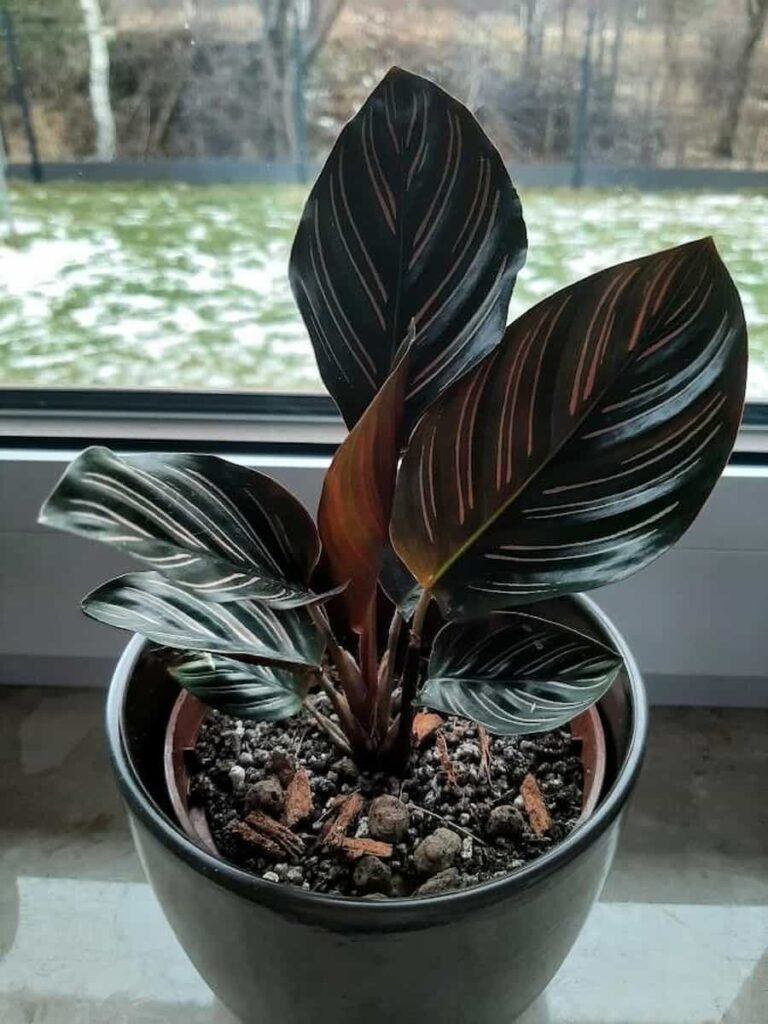
How often should you water calathea ornata?
Calathea ornata likes their soil to dry out just a little between waterings. While each plant varies on when you should water it, expect to water the Calathea ornata about once every 10 to 14 days.
Remember, however, that the exact watering schedule can change depending on the age and size of the Calathea ornata, as well as the conditions of its environment, and even the time of year.
For example, how often you water the plant will typically be reduced during the winter when the plant isn’t actively growing.
The best way to determine whether or not the Calathea needs watered is to simply check the soil. Insert your finger about 2 inches into the soil. Soil that feels damp shouldn’t be watered, while soil that feels dry indicates that the plant does need hydration.
What are calathea ornata’s light requirements?
Calathea ornata grows best when it is placed in an area where the sun is both bright and indirect. This plant doesn’t do well in low light conditions, nor should it be placed in direct sun as it can burn and scorch its leaves.
Calathea ornata can also be grown under artificial light, as long as the light is not shining directly onto the plant’s leaves. Even if the light is artificial, it can still burn and damage the Calathea’s foliage if it is directly shining onto the plant.
If you do use artificial light, you will need to increase the amount of hours the plant receives light. For example, when grown in natural sunlight, the Calathea needs at least 6 hours of sun, while this increases to at least 8 hours of sun when grown under artificial lighting.
You may also be interested in: Calathea Light Requirements: The Ultimate Guide
Where should I put calathea ornata in my house?
The best indoor location for Calathea ornata is in a bright room where the windows face east or west. These windows should also be adorned with sheer curtains that block out any harsh sun rays that may shine through.
If you’re unsure as to where you should put your Calathea ornata, simply take a walk around your house and pay attention to the amount of light that shines into the room. Then choose the location that has the brightest sun.
If the sun shining through the windows is direct and not indirect light, then you will need to use a sheer curtain on the windows. This helps to diffuse the harsh light and protect the leaves from damage.
How often should I water calathea ornata?
Calathea ornata does like regularly watering, but that doesn’t mean you can keep the soil soggy. In fact, this plant prefers its soil to dry out a little between waterings. A good general rule of thumb is to water the plant once every 10 to 14 days.
The exact timeframe for when you water the Calathea ornata will vary depending on your specific plant. A plant that is older or larger may need more watering than one that is smaller and younger.
Furthermore, environmental conditions and even the time of year can also have an impact on how often you water the calathea plant.
When conditions are drier, you will probably have to increase how often the plant is watered. In the winter when the plant isn’t actively growing, you may only need to water the Calathea ornata once every 14 or more days.
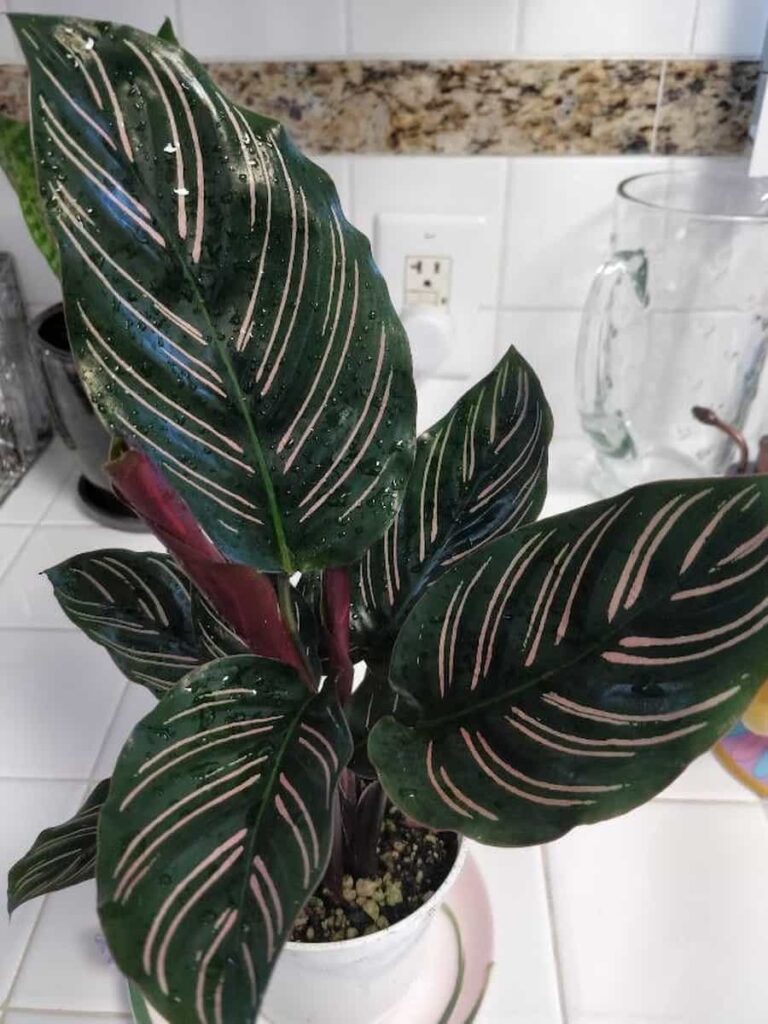
How do I know if my calathea ornata needs water?
Checking to see if the first inch of soil is damp or dry is the best way to determine if your Calathea ornata needs watered. Don’t wait until the plant begins to show signs of underwatering, such as brown and crispy leaves, as it causes unnecessary stress to the plant.
The best way to make sure your Calathea ornata is always watered is to come up with a regular watering schedule. Once you have this schedule in place, you can confirm that it’s time to water the Calathea ornata by inserting your finger two inches into the soil.
Water the Calathea ornata when the soil feels dry. If, however, the soil still feels damp, wait a day or two before testing the soil moisture level again. Only water the Calathea when the top 2 inches of soil feels dry.
Should I bottom water calathea ornata?
Calathea ornata can be watered either in the traditional sense, or you can use the bottom watering technique. This not only helps to prevent overwatering, but it also ensures the Calathea is watered deeply, which promotes root growth.
To use the bottom watering technique, simply fill a container or sink with about 3 to 4 inches of lukewarm water and then submerge the bottom of the Calathea ornata’s pot in the water. Let the plant soak for 10 minutes before checking the soil dryness level.
If the soil still feels dry, continue to soak for another 10 minutes. Continue in this manner, soaking for 10 minutes and then checking the soil, until the soil feels damp. Once it is damp, remove the pot from the water.
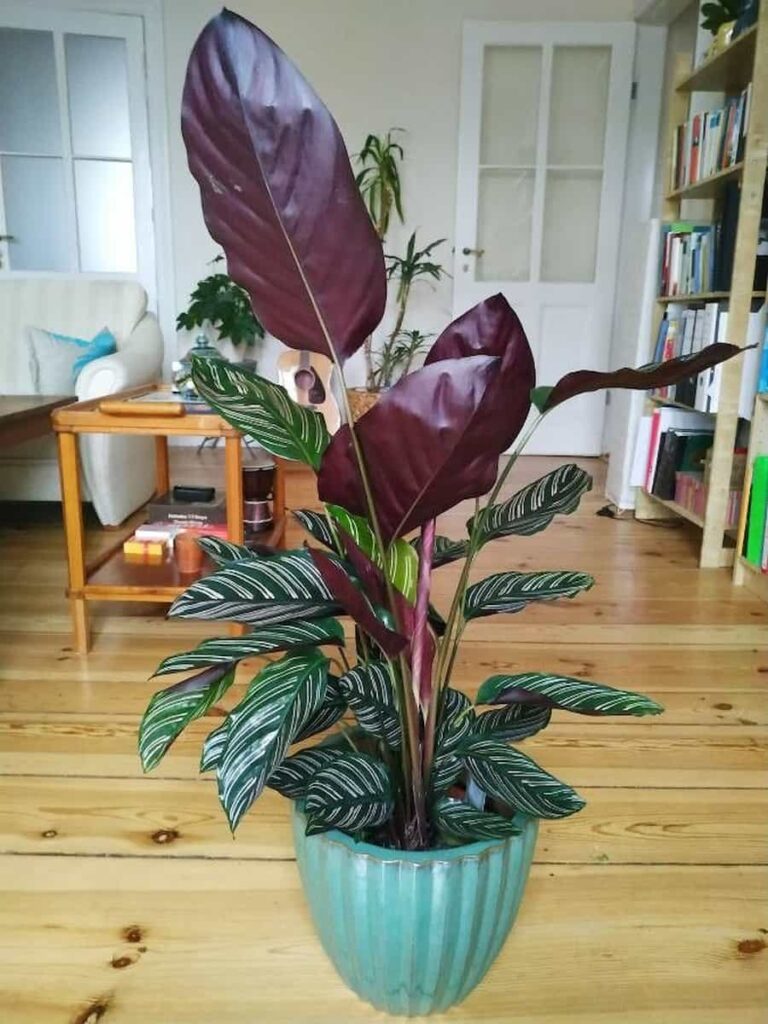
How long should you bottom water a calathea ornata for?
The exact time frame for bottom watering the Calathea ornata varies, but it will typically take about 40 minutes. However, the size and age of the plant, and how dry the soil is will all impact this timeframe.
Since its soaking length can vary so much, it’s best to check the soil dryness every 10 minutes when soaking the Calathea ornata. This helps to prevent the plant’s roots from sitting in water for too long, while also making sure it gets properly watered.
Make sure that, when you bottom water the Calathea ornata, that you are using distilled water and not tap water. This plant is sensitive to tap water, and using it only one can damage the plant’s leaves.
What happens if you water calathea ornata with tap water?
Calathea ornata is one of the many houseplants that cannot tolerate tap water. This is because the plant is sensitive to all the various additives that most cities put into tap water. Tap water has been known to burn the foliage of Calathea ornata, causing its leaves to develop brown edges or spots.
Tap water should be avoided at all costs when watering sensitive plants such as Calatheas.Even if you have exposed the Calathea ornata to tap water before without any signs of a problem, that doesn’t mean it isn’t damaging the plant internally.
The best option when watering Calathea ornata is to use distilled water. Distilled water won’t cause all the potential problems that tap water can lead to, and is the safest choice for sensitive plants, such as Calatheas.

Do calathea ornata like to be misted?
Yes, Calathea ornata are humidity-loving plants, and misting them with distilled water is a great way to keep the leaves hydrated while also increasing the humidity level around the plant. Keep in mind, however, that you shouldn’t mist the plant so much that you are soaking the soil.
Even though they like to be misted, too much water in any form can overwater the plant, which will lead to calathea root rot. That is why it is important to keep an eye on how much water the plant is actually getting.
If you notice the leaves are dripping wet and not drying or the soil is soggy, immediately stop misting the plant. You should also let the soil dry out between waterings.
Should I mist calathea ornata every day?
You can mist your Calathea ornata daily, as long as you are using distilled water and are not misting the plant so much that it is creating a soggy environment. If you notice the Calathea’s leaves are still wet the next day, then you may be misting the plant too much.
As long as you pay attention to the signs that could signify the plant is getting too much moisture, and then stop misting if needed, you can mist the Calathea ornata regularly.
That doesn’t mean, however, that you shouldn’t mist the Calathea ornata every day. In fact, misting the plant every day may be needed, especially when conditions are extremely dry. It’s just vital that you keep your eyes open for signs that the plant is receiving too much mositure.
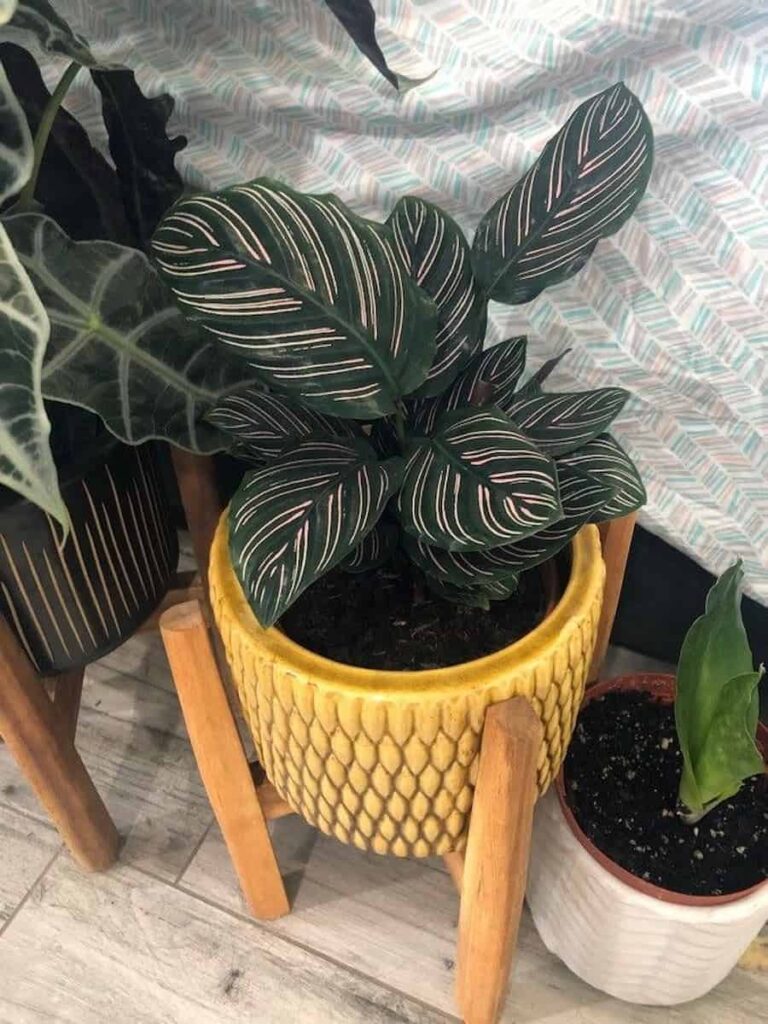
Can you mist calathea ornata with tap water?
Because tap water can cause so many problems for the Calathea ornata, it is best to avoid this when misting the plant. Instead, use distilled water, which is the safest option for plants sensitive to tap water.
Alternatively, you can use filtered water and even rain water. However, distilled water is by far the most recommended option. Distilled water is less likely to have additional minerals that can cause damage to the plant.
If tap water is your only option, consider letting the tap water sit on the counter for 24 hours before watering the Calathea ornata. While this won’t get rid of the minerals, salts, and fluoride often found in tap water, it will give the chlorine enough time to dissipate.
How to propagate calathea ornata
Like other Calathea varieties, the Calathea ornata is propagated via root division. While this is more entailed than simply taking a cutting, it is still not a difficult process. You should, however, wait until the spring or early summer to complete the division process.
To divide the plant, you must first take the Calathea ornata out of its pot and get rid of all the soil around the roots. Then simply divide the roots into separate plants. Each plant is then placed in its own pot and then set in an area where it will receive bright indirect light.
The young Calathea ornatas will need light misting once a day until new growth appears. At this time, stop misting the plant and start caring for it as you would a mature Calathea ornata.
Related: 10 Easy Steps to Propagate Calathea Plants
Do calathea ornata grow fast?
Unfortunately, Calathea ornata are not known for being fast growers. So, if you’re looking to greatly increase the speed at which your plant grows, you’re going to be disappointed. With that said, however, there are things you can do to help promote better growth in your Calathea ornata.
The best way to encourage growth is to ensure the Calathea ornata has the best care possible. This means giving the plant its ideal growing conditions, and fertilizing it in the spring and summer.
You should also avoid situations that have a negative impact on the plant’s growth rate. This includes subjecting the plant to temperatures that are too low or too high, placing the plant in too much or not enough light, and allowing the Calathea to become water stressed.
How do you know if calathea ornata is happy?
The easiest way to tell if your Calathea ornata is happy is to look at the plant. Does it appear healthy with vibrant leaves and strong stems? The simple truth is that a healthy Calathea is a happy Calathea.
An unhealthy Calathea is not happy at all. This is because the plant is stressed and simply fighting for survival. It also leaves the plant open to attacks from insects and diseases, all of which can weaken the plant even more.
You may also be interested in: 9 Proven Steps to Treat a Calathea With Spider Mites
How do you make calathea ornata grow more leaves?
There is no special trick or magic solution to make Calathea ornata grow more leaves. This plant is a slow grower, and will actually push out old leaves to make room for new leaves. This alone reduces the plant’s growth rate.
Ensuring your plant is healthy and happy is the best way to promote leaf growth, as well as fertilizing it with a balanced fertilizer during the plant’s active growing season.
Another way to promote leaf growth is to simply be on the lookout for any potential problems that may develop and quickly address any issues that arise. The longer the Calathea ornata experiences problems, the higher the chance the growth rate of its leaves will become affected.
What’s a calathea ornata sanderiana?
Calathea ornata Sanderiana is the same plant as Calathea ornata, it is just a different name for the plant. Calathea ornata is also commonly called a prayer plant, as well as the pinstripe calathea or pinstripe plant.
Ultimately, don’t let all these names confuse you – they’re all referring to the same plant with the same, beautiful foliage!
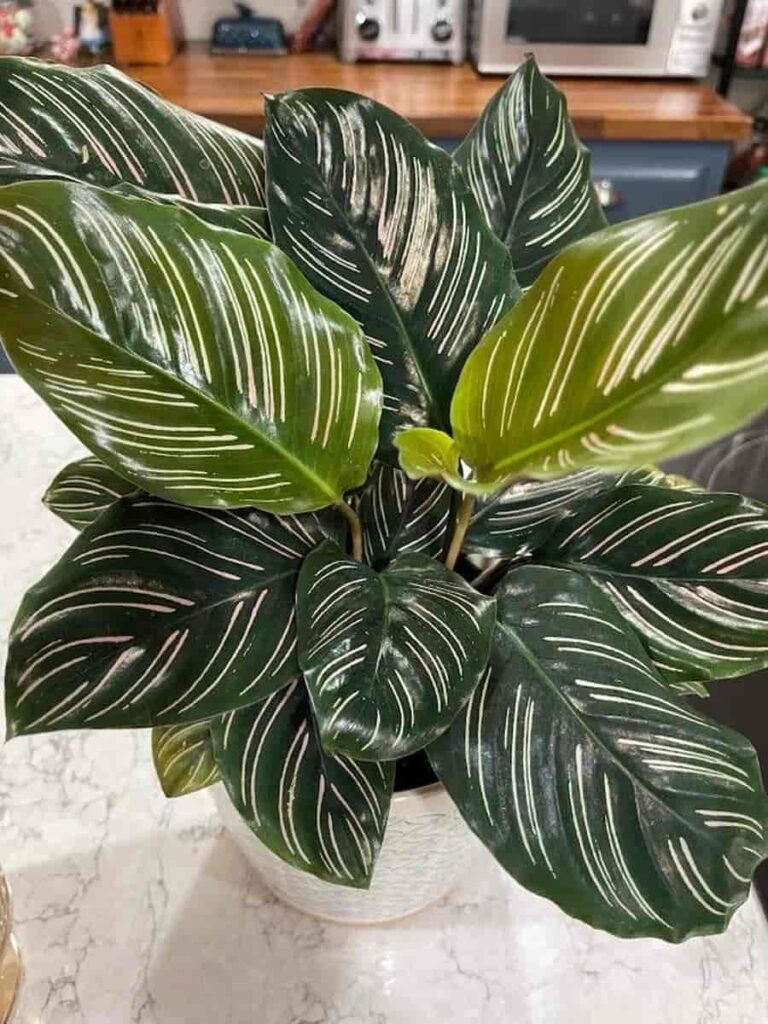
Is calathea ornata toxic to cats and dogs?
Calathea ornata is not toxic to cats or dogs, nor does it pose a risk to humans. This means the plant makes a great option for homes with pets. Despite being non-toxic, the Calathea ornata can still cause lethargy, drooling, vomiting, and diarrhea if your cat or dog consumes it.
Thankfully, these symptoms are not usually life threatening and subside within 24 to 48 hours. Even though they are more of an unpleasant experience and not a serious concern, you should still keep your cats and dogs away from the Calathea ornata.
Allowing your pets to bother any plant that isn’t meant for them increases the chance that they will damage that plant.
It could be as simple as a torn leaf or something more extensive, such as a broken stem. No matter what, this can stress and potentially kill the Calathea ornata.
Related: Is Calathea Toxic to Cats, Dogs or Humans?
Why are the tips of my calathea ornata’s leaves turning brown?
When the tips of the Calathea ornata‘s leaves turn brown, it is a sure sign that the plant has been exposed to tap water. While many plants have no problem with tap water, Calatheas are actually sensitive to this water and it can essentially cause the plant to experience a chemical burn.
The only good thing about this is that once you stop watering the Calathea ornata with tap water, you shouldn’t have any problems. Unfortunately, the leaves that have started to develop brown tips won’t revert to their previous appearance.
The best way to ensure the Calathea ornata doesn’t develop brown tips in the future is to only use distilled water when watering or misting the plant.
Related: 12 Causes of Brown Spots on Calathea (+ How to Fix It)
Why are my calathea ornata’s leaves curling?
Seeing the leaves on your Calathea ornata start to curl can be a stressful sight, especially if you’re not sure what is causing the problem. Thankfully, this issue is typically caused by underwatering the Calathea. While that isn’t a good thing, it is much easier to manage than some other problems.
To fix the problem, you will need to soak the Calathea ornata in lukewarm water for 30 to 40 minutes. This good soaking will help thoroughly hydrate the plant.
After the soaking, start a regular watering schedule to help prevent the Calathea ornata from becoming underwatered again.
An underwatered plant isn’t usually as serious of a problem as overwatering it, but it can still cause a slew of problems. When a plant is underwatered, it puts stress on the Calathea that can weaken it. In this weakened state, the plant is less likely to withstand attacks from insects and diseases.
You may also be interested in: 6 Causes of Your Calathea Leaves Curling (+ How to Fix It)
Why are my calathea ornata’s leaves drying?
The most common cause of the Calathea ornata‘s leaves drying is that the plant is underwatered. When the plant isn’t properly hydrated, its leaves will begin to dry. These leaves may also turn brown, curl, and even fall off the plant.
To revive an underwatered Calathea ornata, simply soak the plant in a bucket of water for about 30 minutes. After the time has passed, lift the plant out of the bucket and let the excess water drain out. Then simply place the plant back in its position.
You should also implement a good watering schedule to prevent this from reoccurring.
